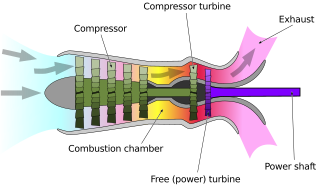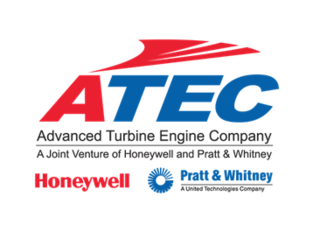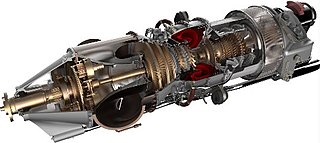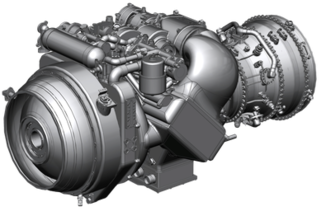
The Rolls-Royce Turbomeca RTM322 is a turboshaft engine produced by Safran Helicopter Engines. It was originally conceived and manufactured by Rolls-Royce Turbomeca Limited, a joint venture between Rolls-Royce plc and Turbomeca. The engine was designed to suit a wide range of military and commercial helicopter designs. The RTM322 can also be employed in maritime and industrial applications.

The LHTEC T800 is a turboshaft engine for rotary wing applications. It is produced by the LHTEC, a joint venture between Rolls-Royce and Honeywell. The commercial and export version is the CTS800. The engine was primarily developed for the United States Army's cancelled RAH-66 Comanche armed reconnaissance helicopter, but has found use in other applications.

GE Aerospace is an aircraft engine supplier, headquartered in Evendale, Ohio, outside Cincinnati. Not only does GE Aerospace manufacture engines under its umbrella, it also partners with other manufacturers. CFM International, the world's leading supplier of aircraft engines and GE's most successful partnership, is a 50/50 joint venture with the French company Safran Aircraft Engines. As of 2020, CFM International holds 39% of the world's commercial aircraft engine market share. GE Aerospace's main competitors in the engine market are Pratt & Whitney and Rolls-Royce.

A turboshaft engine is a form of gas turbine that is optimized to produce shaft horsepower rather than jet thrust. In concept, turboshaft engines are very similar to turbojets, with additional turbine expansion to extract heat energy from the exhaust and convert it into output shaft power. They are even more similar to turboprops, with only minor differences, and a single engine is often sold in both forms.

The General Electric GE38 is a gas turbine developed by GE Aviation for turboprop and turboshaft applications. It powers the Sikorsky CH-53K King Stallion as the T408.

The General Electric T700 and CT7 are a family of turboshaft and turboprop engines in the 1,500–3,000 shp (1,100–2,200 kW) class.

The Avco-Lycoming AGT1500 is a gas turbine engine. It is the main powerplant of the M1 Abrams series of tanks. The engine was originally designed and produced by the Lycoming Turbine Engine Division in the Stratford Army Engine Plant. In 1995, production was moved to the Anniston Army Depot in Anniston, Alabama, after the Stratford Army Engine Plant was shut down.

The Bell Huey family of helicopters includes a wide range of civil and military aircraft produced since 1956 by Bell Helicopter. This H-1 family of aircraft includes the utility UH-1 Iroquois and the derivative AH-1 Cobra attack helicopter series and ranges from the XH-40 prototype, first flown in October 1956 to the 21st-century UH-1Y Venom and AH-1Z Viper.

The Honeywell T55 is a turboshaft engine used on American helicopters and fixed-wing aircraft since the 1950s, and in unlimited hydroplanes since the 1980s. As of 2021, more than 6,000 of these engines have been built. It is produced by Honeywell Aerospace, a division of Honeywell based in Phoenix, Arizona, and was originally designed by the Turbine Engine Division of Lycoming Engines in Stratford, Connecticut, as a scaled-up version of the smaller Lycoming T53. The T55 serves as the engine on several major applications including the CH-47-Chinook, the Bell 309, and the Piper PA-48 Enforcer. The T55 also serves as the core of the Lycoming ALF 502 turbofan. Since the T55 was first developed, progressive increases in airflow, overall pressure ratio, and turbine inlet temperature have more than tripled the power output of the engine.

The Advanced Turbine Engine Company (ATEC) is an American aerospace joint venture created in 2006. A project of Honeywell International Inc. and Pratt & Whitney, ATEC was formed to compete for a government contract to create a 3,000 shaft horsepower engine to replace the existing 2,000 shaft horsepower T700 engine powering the U.S. Army's Sikorsky UH-60 Black Hawk and Boeing AH-64 Apache helicopters.

A free-turbine turboshaft is a form of turboshaft or turboprop gas turbine engine where the power is extracted from the exhaust stream of a gas turbine by an independent turbine, downstream of the gas turbine. The power turbine is not mechanically connected to the turbines that drive the compressors, hence the term "free", referring to the independence of the power output shaft. This is opposed to the power being extracted from the turbine/compressor shaft via a gearbox.

Atec, Inc. specializes in the design, manufacture, construction and maintenance of precision components, large fabrications, systems and facilities. Atec provides solutions for low to medium volume requirements involving engine test, aero support equipment, spaceflight components, and energy service products. Over 20,000 Atec products have been used by the United States Armed Forces and others, including the Federal Aviation Administration. Atec was named NASA Small Business Subcontractor of the Year for 2016, in recognition of contributions to NASA and Boeing Manned Spaceflight Programs.

The General Electric Catalyst is a turboprop engine by GE Aviation. It was announced on 16 November 2015 and will power the Beechcraft Denali, it first ran on December 22, 2017, and should be certified in 2024. The 850 to 1,600 hp engine aims for 20% better efficiency than its competition thanks to a 16:1 overall pressure ratio, variable stator vanes, cooled turbine blades, 3D printed parts and FADEC.

The Sikorsky–Boeing SB-1 Defiant was the Sikorsky Aircraft and Boeing entry for the United States Army's Future Long-Range Assault Aircraft program to replace the Sikorsky UH-60 Black Hawk. It is a compound helicopter with rigid coaxial rotors, powered by two Honeywell T55 turboshaft engines; it first flew on 21 March 2019.

The Future Affordable Turbine Engine (FATE) is a US Army program for a 5,000-10,000-shp class turboshaft/turboprop for Future Vertical Lift aircraft and its Joint Multi Role precursor.

The General Electric T901 (GE3000) is a turboshaft engine in the 3,000 shp (2,200 kW) class currently under development for the United States Army's Improved Turbine Engine Program (ITEP). The ITEP plans after 2025 to re-engine over 1,300 Sikorsky UH-60 Black Hawk and more than 600 Boeing AH-64 Apache, and power the Future Attack Reconnaissance Aircraft (FARA).
The Bell 360 Invictus is a proposed helicopter design intended to meet the United States Army requirement for a Future Attack Reconnaissance Aircraft (FARA). It is based on technology from the Bell 525 Relentless.
The Future Attack Reconnaissance Aircraft (FARA) program was initiated by the United States Army in 2018 to develop a successor to the Bell OH-58 Kiowa scout helicopter as part of the Future Vertical Lift program. The OH-58 was retired in 2014; three prior programs for a successor were cancelled prior to reaching production: Light Helicopter Experimental, Armed Reconnaissance Helicopter, and Armed Aerial Scout.
The Sikorsky Raider X is a compound helicopter concept with two coaxial rotors and a single pusher propeller, designed by the Sikorsky Aircraft division of Lockheed Martin for the United States Army Future Attack Reconnaissance Aircraft (FARA) program. The Raider X concept was announced in October 2019. In March 2020, the Army selected the Raider X and the Bell 360 Invictus from a field of five design concept candidates. The Raider X and 360 Invictus concepts will be built as flying prototypes for a competition scheduled for 2023.

The ATEC T901 (HPW3000) was a turboshaft engine in the 3,000 shp (2,200 kW) class under development for the United States Army's Improved Turbine Engine Program (ITEP). The ITEP plans to re-engine over 1,300 Sikorsky UH-60 Black Hawk and more than 600 Boeing AH-64 Apache, and to power the Future Attack Reconnaissance Aircraft, beginning after 2025. The T900 was developed by the Advanced Turbine Engine Company (ATEC), a joint venture between Honeywell Aerospace and Pratt & Whitney. In February 2019, the US Army selected the GE T901 as the winner of the program.


















